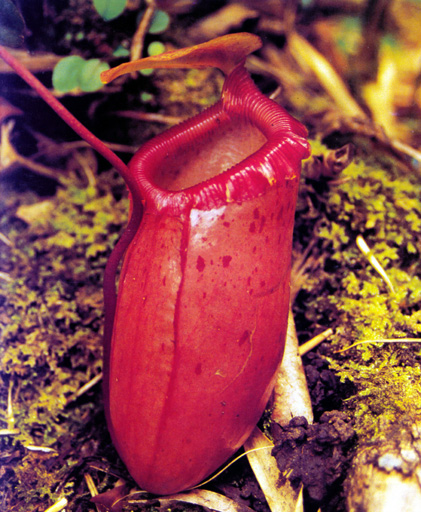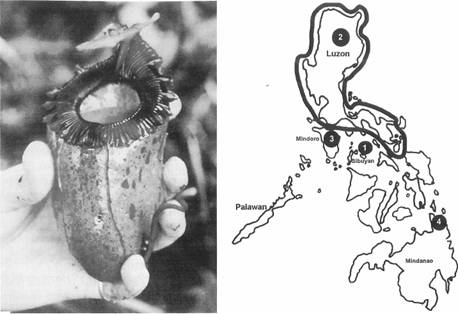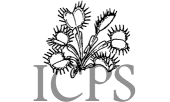|
Carnivorous Plant Newsletter
Volume 27, Number 1, March 1998, pages 18-23
NEPENTHES SIBUYANENSIS,
A NEW NEPENTHES FROM SIBUYAN,
A REMOTE ISLAND OF THE PHILIPPINES
Dr. Joachim Nerz • Boblingen • Germany
Phill Mann • Harvey • Western Australia
Thomas Alt • Lebach-Aschbach • Germany
Trend Smith • Makati, Manila • Philippines
Keywords: new taxa: Nepenthes sibuyanensis.
Received: 11 July 1997
Summary
A new species of Nepenthes from Mt. Guintguintin on Sibuyan Island, Philippines is described and illustrated.
Introduction
In September 1996, Thomas Alt, Phill Mann, Trend Smith and Alfred Öhm started an expedition to some Philippine islands in search for Nepenthaceae. One of these was Sibuyan Island; it belongs to a group of small isolated islands located between the Northern islands of Luzon/Mindoro and the Southern islands of Cebu. At the centre of Sibuyan Island there is a high mountain named Mt. Guintguintin with an altitude of 2057 m. Here three species of Nepenthaceae have been found. One of them, Nepenthes sibuyanensis, will be described in this paper; another one (N. argentii) was described recently (Jebb & Cheek, 1997).
Nepenthes sibuyanensis Nerz sp. nov.
Folia mediocria sessilia, lamina lineari-lanceolata, nervis longitudinalibus utrinque 5-6, basi in alas 2 decurrente, vagina 0.; ascidia mediocria v. maiora, ovata v. infundibuliformia, costis 2 prominentibus, nonnunquam ad os rudimento alae ciliatae ornatis; peristomio operculum versus acuminate in collum breve elongato, applanato, 20 mm lath, costis 1.5 - 2 mm distantibus, dentibus 5 x longioribus quam latis. Operculo ovatocordato, facie inferiore piano; inflorescentia racemus parvus pedicellis 8 mm longis, omnibus 1-floris; indumentum in partibus vegetativis subnullum, in inflorescentiis densum adpressum, e pills simplicibus compositum.
Holotypus: P. Mann & T. Smith, Mt. Guintguintin, Sibuyan island, Philippines, 1300 m above sea level, growing between Dipteris and high grasses on open slopes, 5/10/1996, 051001(L)1.
-----------------
1 The sheet 051001 (L) contains a typical pitcher of Nepenthes sibuyanensis; this material was chosen as holotype because the pitcher of Nepenthes sibuyanensis is the most characteristic organ of this species.
-----------------
Stems short, up to 0.7 m long, the part with adult leaves about 8 mm in diameter, cylindrical to asymmetrical in cross-section, the internodes 1-1.5 cm long. Leaves thincoriaceous, sessile, linear-lanceolate or slightly spathulate, broadest little above the middle, 10 to 15 cm long, 3-3.5 cm broad, acute, gradually attenuate to the base, decurrent into 2 attenuate wings on two angles of the stem over 2/3 to nearly the whole internode. Longitudinal nerves 5 to 6 on each side, originating in the basal part of the midrib, running parallel in the outer half of the leaf; tendrils 1 to 2 times as long as the pitcher, about 2 to 3 mm thick near the leaf, 7 to 9 mm near the pitcher. Pitchers incurved from the hanging end of the tendril, the curve is tightly appressed to the pitchers; pitchers ovate to infundibuliform, 20 cm high, 12 cm wide in the widest part beneath the mouth, with two prominent ribs over the whole length, with 2 scarcely fringed wings in the upper 2/3 of the pitcher, 2 to 3 mm broad. Mouth oval, almost horizontal to slightly oblique, usually elongated into a short neck. Peristome cylindrical, 20 mm broad, the ribs 2 mm apart, 1 mm high, the teeth of the inner margin about 3 to 4 mm long, up to 5 times as long as broad. The whole inner surface of the pitcher is glandular. Glands at the bottom of the pitcher are approximately 500 cm-2, overarched, about 0.1 to 0.2 mm in diameter, below the rim 200-250 cm-2, about 0.5 to 0.8 mm in diameter, not overarched; lid broadly ovate-cordate, 8 cm long, 6.5 cm broad, rounded at the apex, usually slightly cordate, without appendages, small compared with size of mouth; glands ovate, deepened, 1 mm in diameter, concentrated at the central part; only few, scattered. Midrib of the lid prominent at the basal half, branching at the apical end into 2 to 3 longitudinal nerves. Longitudinal nerves 5 to 6 on each side, originating in the basal part of the lid, branched at the end. Spur filiform, 2-3 mm long, 0.5 mm in diameter, insertion at the base of the lid. Male inflorescence a raceme, the peduncle at least 18 cm long, 6 mm thick at the base, the axis 15 cm long, the pedicels all of them 1-flowered, with no or much reduced bract, the lower ones 12-14 mm long, the upper ones little shorter. Tepals oblong, about 3 mm long, obtuse. Staminal column about 5 mm long, the anthers inclusive. Anthers uniseriate. Fruit 18 to 22 mm long, the valves lanceolate, 3 to 4 mm broad. Seeds filiform, 8 mm long. Indumentum: In the vegetative parts almost none, the inflorescense very densely and adpressed stellate-hairy, staminal column sparsely covered with short hairs. Colour of herbarium specimens light brown to reddish, pitchers light brown to reddish, rim dark brown, pitchers with few reddish spots in the upper part, 5 to 10 mm in diameter. Interior of the pitcher shiny brown. Colour of living specimen: Leaves yellowish to dark green, midrib light green; pitchers yellowish to orange, sometimes with some few scattered red spots beneath the mouth, 5 to 10 mm in diameter, rim dark red to black, lid yellowish to orange (Figure 1; Figure 2).
Distribution and Ecology
Nepenthes sibuyanensis is known only from its type locality at Mt. Guintguintin, Sibuyan Island; here it grows quite sparsely on open grassy slopes among Dipteris conjugata and high grasses; small shrubs also grow in the same area. It occurs at altitudes from 1500 to 1800 m. Characteristically the pitchers are hidden in the ground; the pitchers are of pale yellow to slightly reddish colour with some red spots. The rim is usually dark red to blackish. The only pitcher which has been found growing in the sun was orange to reddish with a shiny red rim. At Mt. Guintguitin two more species of Nepenthes have been found, one grows in abundance at lower altitudes (800-1000 m) in bushes and seems to be closely related to N. alata. The other one is a small new species which has been found at about 1800 m above sea level on steep slopes in open places. Very few specimens of it have been found. This species has been described recently as Nepenthes argentii (Jebb & Cheek, 1997, pp. 19-22). A range map is included in Figure 3.
Systematic Links
The characteristics of Nepenthes sibuyanensis show it to be a member of the group Insignes, to which belong Nepenthes merrilliana Macfarl., Nepenthes insignis Danser, Nepenthes burkei Masters and Nepenthes ventricosa Blanco. These species seem to be the nearest relatives of Nepenthes sibuyanensis. It is remarkable that Nepenthes sibuyanensis shows morphologic features which are intermediate especially between Nepenthes merrilliana Macfarl. and Nepenthes ventricosa Blanco. Also geographically, Nepenthes sibuyanensis is situated between these two species. Nepenthes merrilliana Macfarl. is only known from Mindanao, an island located South of Sibuyan, and Nepenthes ventricosa Blanco is just known from Luzon, North of Sibuyan. Maybe Nepenthes sibuyanensis is a species intermediate between Nepenthes merrilliana Macfarl. and Nepenthes ventricosa Blanco.
Table 1: Species that seem to be closely related to Nepenthes sibuyanensis are compared. Characteristics clearly distinguishing Nepenthes sibuyanensis from Nepenthes merrilliana, Nepenthes insignis, Nepenthes burkei, and Nepenthes ventricosa are shown.
Characteristics |
Nepenthes sibuyanensis |
Nepenthes merrilliana |
Nepenthes insignis |
Nepenthes burkei |
Nepenthes ventricosa |
teeth of interior
margin of rim |
distinct teeth, 5 times
as long as broad, 5
mm long |
teeth of interior
margin of rim as long
as broad, small, 1
mm long |
teeth of interior
margin of rim as
long as broad,
small, 1 mm long |
teeth of interior
margin of rim as
long as broad,
small, about 0.5
to 1mm long |
teeth of interior
margin of rim 2 to
3 times as long as
broad, 1 to 2 mm
long |
rim |
with distinct, 1 mm
deep ribs, 2 mm apart |
ribs 0.5 to 1 mm
apart |
ribs 0.5 to 1 mm
apart |
ribs 0.5 to 1 mm
apart |
ribs 0.5 to 1 mm
apart |
neck of rim |
borders of rim close
together at neck, with
a distinct neck |
borders of rim do not
fit together at the
upper end near the
id, leaving a distinct
gap |
rim towards the
lid without neck |
rim towards the
lid with slightly
developed neck |
rim towards the lid
without or with
slightly developed
neck |
wings |
pitchers without or
just slightly developed
wings in the upper
half of the pitcher |
lower pitchers with
well developed,
fringed wings |
lower pitchers
rarely with 2
narrow wings |
lower pitchers
without or just
slightly
developed wings
in the beyond
the rim |
lower pitchers
without wings |
shape of
lower pitchers |
ovate to slightly
infundibulate |
ovate |
ovate in the
lower half,
cylindric in the
upper half |
ventricose
below, slightly
constricted in
the middle |
slightly ventricose
below, constricted
in the middle |
lid |
broadly ovate-cordate,
8 cm long, 6.5 cm
broad, glands at the
lower surface rather
large, concentrated at
the central part of the
lid, few, scattered
|
ovate, 12 to 14 cm
long, 5 to 6 cm
broad, few minute
glands at the lower
surface |
orbiculate to
ovate, up to 5 cm
long, up to 4.5 cm
broad, many
glands at the
lower surface,
rather large,
aggregated near
the 2 main lateral
nerves, missing in
the median and
lateral part |
ovate-cordate, 5
to 8 cm long, 3
to 5 cm broad,
few glands at the
lower surface,
aggregated near
the lateral
nerves |
ovate-cordate, 3 to
4 cm long, 2 to 3
cm broad, small
compared with the
size of mouth/few
glands at the lower
surface, aggregated
near the lateral
nerves |
insertion of
mouth |
almost horizontal |
distinct oblique |
slightly oblique |
slightly oblique |
almost horizontal |
size of pitchers |
up to 26 cm |
up to 30 cm |
20 to 35 cm |
15-20 cm |
10-15 cm |
male
inflorescence |
1-flowered |
2-flowered |
2-flowered |
1-flowered |
1-flowered |
growth form |
in grassy area, plants
short, 0.5-0.7 m, no
climbing plants known |
sometimes climbing
up to several meters
in shrubs |
frequently
epiphytic on
trees, shortly
climbing |
unknown |
climbing in shrubs,
up to 2 m |
Specimens Examined
Nepenthes sibuyanensis: P. Mann & T. Smith, pitcher, Mt. Guintguintin, Sibuyan island, Philippines, 1300 m above sea level, growing between Dipteris sp. and high grasses on open slopes, 5/10/1996, 051001(L-holotype); P. Mann & T. Smith, Mt. Guintguintin, vegetative part without pitchers, Sibuyan island, Philippines, 1300 m above sea level, 5/10/1996, 051002 (L); P. Mann & T. Smith, Mt. Guintguintin, fruit, Sibuyan island, Philippines, 1300 m above sea level, 5/10/1996, 051003 (L); P. Mann & T. Smith, Mt. Guintguintin, male flower, Sibuyan island, Philippines, 1300 m above sea level, 5/10/1996, 051004 (L).
Nepenthes merrilliana: D. Mendosa & P. Convocar, Mt. Kabatuan, Surigao Province, April 1919, 10523 (MAN); M. Ramos & J. Pascasio, Surigao Province, Mindanao, 34503 (BO).
Nepenthes insignis: Brass, 4 km SW of Bernhard Camp, Idenburg Rivier, 3/1939, 13379 (BO); 8 km SW of Bernhard Camp, Idenburg Rivier, 3/1939, 13669 (BO); Docters van Leeuwen, border of affluent C of the Rouffaer River, 250 m, 9/1926, 10258 (BO-type), Docters van Leeuwen, Rouffaer River, 9/1926, 10286 (BO), Pulle 277, Border of the Beaufort River, 80 m, 9/1111912, 201110 (L).
Nepenthes ventricosa: H. C. Conklin & Buwaya, Bayninan, Banaue, Ifugao, Mt. Province, Luzon, 5000 ft. above sea level, 29/3/1963, 79644 (L); G. E. Edano, Mt. Magnas, Apayao Subprovince, Luzon, June 1953, 19754 (MAN); D. R. Mendosa, Sumigar, Banaue, Ifugao, forest slope or open and on road cuts, 17/5/1967, 97469 (MAN).
Nepenthes burkei: G. E. Edano, Mt. Halcon, Mindoro, summit 2828 m, 15/2/1948, 3375 (MAN); C. E. Ridsdale, M. J. E. Coode, E. Reynoso, N-coast Mindoro, Subaan River headwaters, inland from San Teodoro, mossy forest on ridge, 920 m, 2/5/1986, 5689 (K).
Besides the study of herbarium material we had also the opportunity to examine living plants of Nepenthes merrilliana at its natural habitat at 'Red Hill', Mindanao and to examine living cultivated material of Nepenthes ventricosa and Nepenthes burkei in several Botanic Gardens and private collections.
Acknowledgments
We would like to thank Heiko Rischer and Andreas Wistuba for helpful general discussions and Matthias Schmidt for preparing the illustrations.
References:
Blanco, F.M. 1837, Nepenthes, Flora de Filipinas, 1, ed., pp. 805-809.
Danser, B.H. 1928, The Nepenthaceae of Netherlands Indies, Bull. Jard. Bot. Buitenzorg, 3. Ser. 9 (Livr. 3-4).
Jebb, M. & M. Cheek 1997, A Skeletal Revision of Nepenthes (Nepenthaceae), Blumea, 42, 1-106.
Macfarlane, J.M. 1927, The Philippine Species of Nepenthes, The Philippine Journal of Science, 33 (2), 127-140.
Macfarlane, J.M. 1911, New Species of Nepenthes, Contributions from the Botanical Laboratory of the University of Pennsylvania, 3 (3), 207 ff.
Masters, M.T. 1889, New or Noteworthy Plants, The Gardener s ' Chronicle, 3. ser, 6, 492.

Front Cover: Nepenthes sibuyanensis. Photo by Phill Mann.

Figure 1: Nepenthes sibuyanensis. A. leaf with typical pitcher. B. lower surface of lid. C. pitcher from a sunny position. D. typical rosette. E. stem with insertion of leaf. F. ripe capsules.

Figure 2 (left): Nepenthes sibuyanensis.
Figure 3 (right): Distribution of Nepenthes sibuyanensis, Nepenthes merrilliana, Nepenthes ventricosa and Nepenthes burkei at the Philippines.
|

